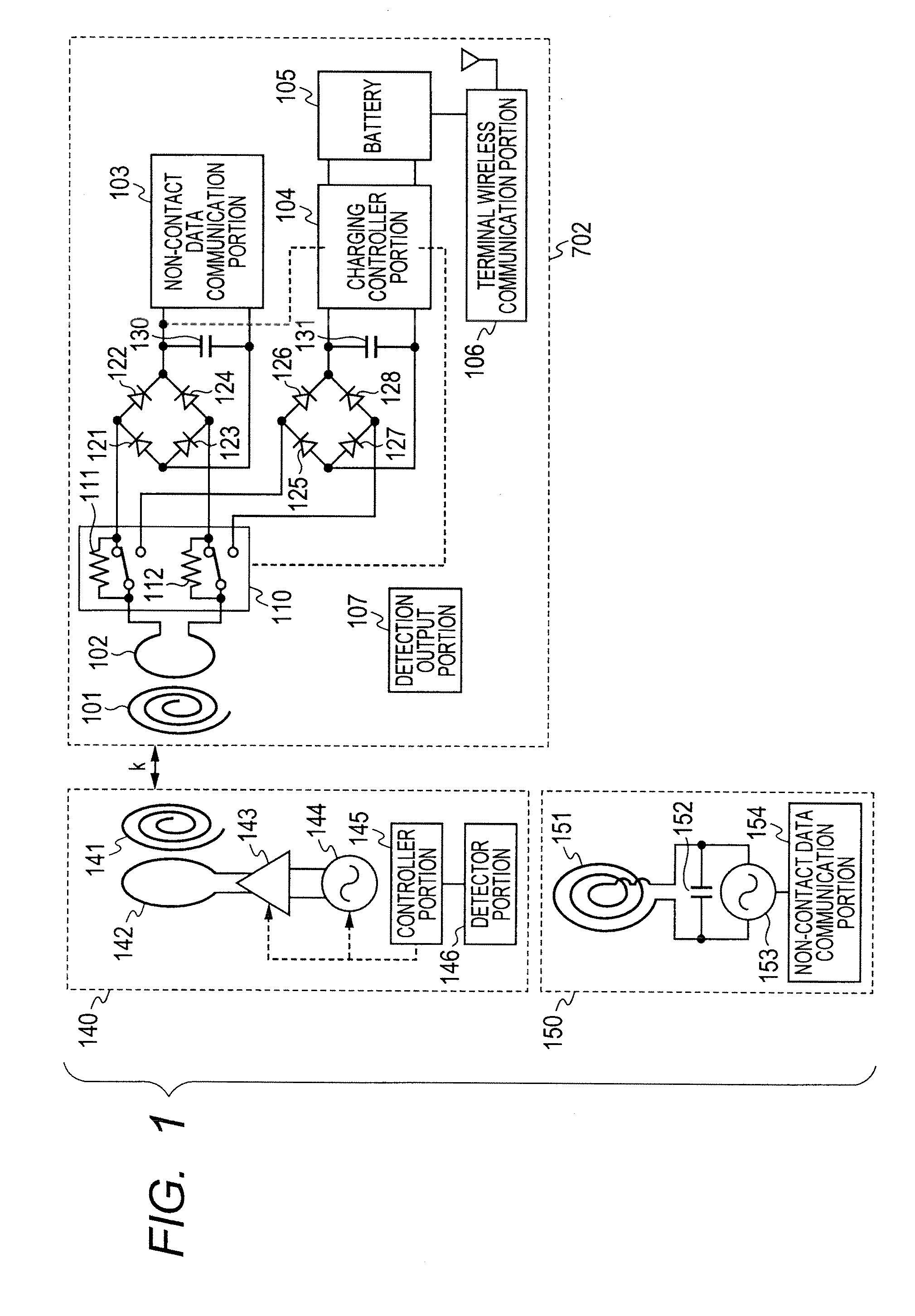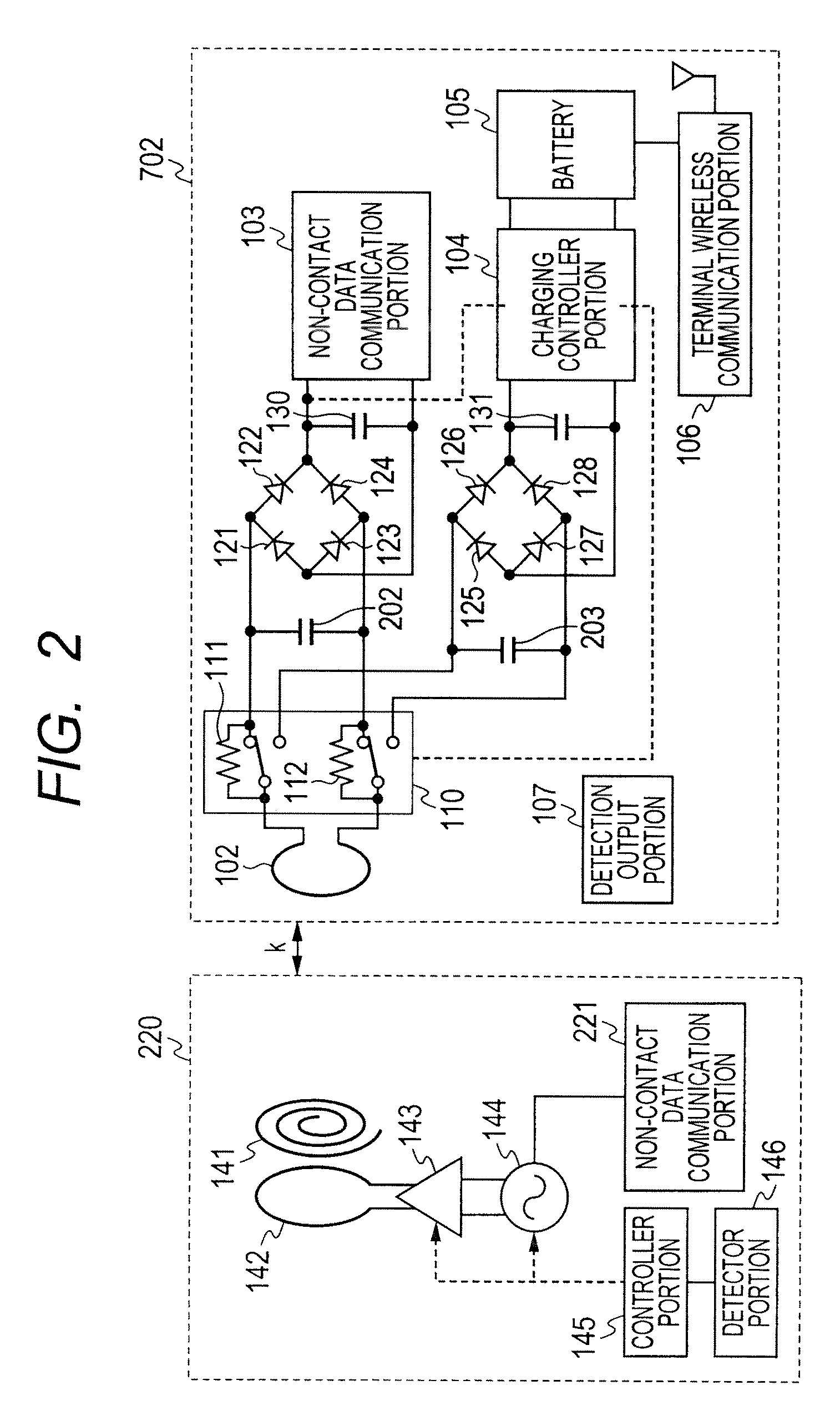Non-contact power transmission system, receiving apparatus and transmitting apparatus
a power transmission system and non-contact technology, applied in the direction of near-field systems using receivers, instruments, transportation and packaging, etc., can solve the problems of shortening the transmission distance, difficult to reduce the size of portable terminal devices, and restricting the position of mounting, so as to reduce the fluctuation of frequency characteristics, the effect of superior transmission efficiency and superior efficiency
- Summary
- Abstract
- Description
- Claims
- Application Information
AI Technical Summary
Benefits of technology
Problems solved by technology
Method used
Image
Examples
embodiment 1
[0073]Explanation will be given on a first embodiment of a non-contact power charging system, according to the present invention, by referring to drawings attached herewith.
[0074]FIG. 1 is a view for showing the first embodiment having the non-contact power charging system to be applied in the present invention.
[0075]In the figure, a reference numeral 702 depicts a mobile or portable terminal device, 140 a transmitting apparatus for conducting non-contact transmission of electric power, 150 a non-contact communicating apparatus, wherein the portable terminal device 702 shown in the figure comprises a magnetic resonance coil 101, a load coil 102, an changeover switch 110, rectifying diodes 121, 122, 123, 124, 125, 126, 127 and 128, smoothing capacitors 130 and 131, a non-contact data communication portion 103, a charging controller portion 104, a battery 105, a terminal wireless communication portion 106, and a detection output portion 107, and further damping or attenuating resistor...
embodiment 2
[0089]FIG. 2 is a view for showing a second embodiment of the non-contact power charging system, to be applied in the present invention.
[0090]The figure shows that applying a coil of the electromagnetic induction method in the portable terminal device 702 while a coil of the magnetic resonance method in a power transmitting apparatus 220, comparing to the first embodiment shown in FIG. 1. However, in the figure, although there is applied the power transmitting apparatus 220 unifying the communication apparatus and the power transmitting apparatus in one body, but the present invention should not be limited to this. As was shown in FIG. 1, the coil of the electromagnetic induction method may be applied to the portable terminal device while applying the coil of the magnetic resonance method to the power transmitting apparatus, even in case where the communication apparatus and the power transmitting apparatus are separated from each other.
[0091]In the figure, a reference numeral 201 d...
embodiment 3
[0100]FIG. 3 is a view for showing a third embodiment of the non-contact power charging system, to be applied in the present invention.
[0101]In the figure, a reference numeral 301 depicts a resonance capacitor, 310 a changeover switch, 311 an attenuation resistor, 312, 313, 314 and 315 rectifying diodes, which are used in common with in the non-contact communication and the non-contact power transmission, but others corresponding to those shown in FIG. 2 are attached with the same reference numerals, and the explanations thereof will be omitted herein.
[0102]In the power transmitting apparatus 220, when conducting the non-contact communication between the portable terminal device 702, the non-contact data communication portion 221 modulates the oscillation signal of the oscillator 144 in accordance with the communication data, and the signal modulated is amplified by the amplifying portion 143, to be transmitted through a power transmission antenna, which is constructed with the powe...
PUM
 Login to View More
Login to View More Abstract
Description
Claims
Application Information
 Login to View More
Login to View More - R&D
- Intellectual Property
- Life Sciences
- Materials
- Tech Scout
- Unparalleled Data Quality
- Higher Quality Content
- 60% Fewer Hallucinations
Browse by: Latest US Patents, China's latest patents, Technical Efficacy Thesaurus, Application Domain, Technology Topic, Popular Technical Reports.
© 2025 PatSnap. All rights reserved.Legal|Privacy policy|Modern Slavery Act Transparency Statement|Sitemap|About US| Contact US: help@patsnap.com



